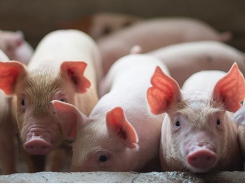Flavors in sow feed improve piglet performance, says German player

German producer, Phytobiotics, launched a new flavor and sweeteners line – Miracol - at VIV Europe in Utrecht for use in in all animal species and at every stage of life.
“The creamy and milky notes, which are rounded off with vanilla and cinnamon, are for young animals, they are especially useful in milk replacers; calves and piglets prefer milky notes in their feed. The fruity notes are for all kinds of feed and for application in all animal species,” Kathrin Rieser, product manager flavors, Phytobiotics, told us.
Sweeteners are also included under the Miracol brand. “Most of those are purely plant based.”
Extracts of dry stevia leaves are used in its Appitello Naturele product to enhance palatability of feed.
It is a flexible flavor line. “We can combine different notes to make tailor made and customer specific solutions.”
The use of flavors can enhance feed palatability, acceptance and intake, she said.
“You can make feed formulation more flexible if you can mask some ingredients such as amino acids which have a bitter taste by using flavors.”
Cows and pigs are much more sensitive to flavors and taste in comparison to chickens because they have more receptors, added Rieser.
Information transfer from sow to offspring
In that context, Phytobiotics was also pushing home the concept that the acceptance of solid feed in piglets after weaning is related to prenatal flavor exposure.
It has a range of encapsulated flavors to be used in both sow and piglet feed.
Jessika Ibarrola van Leeuwen, species manager swine at Phytobiotics, told us about the benefits of exposing piglets prenatally and perinatally to flavors.
Studies conducted at Wageningen University (Oostindjer et al, 2009, 2010, 2011) have shown that by using the same flavors in gestation, lactation and weaner diets improves piglet performance, reduces stress and leads to less diarrhea, she explained.
Piglets can remember these flavors and adapt their intake accordingly. The acceptance of solid feed after weaning is related to prenatal flavor exposure, said van Leeuwen.
“Marije Oostindjer did her PhD on vertical learning in pigs. She exposed piglets in the uterus to different types of flavors and then compared the weaning performance of those piglets to those that did not have that exposure or only had exposure to flavors post birth.”
The research confirmed that the transfer of information from mother to offspring about feed – vertical learning - starts in the uterus.
The fetuses are exposed to the flavors from the maternal diets present in the amniotic fluid and this exposure increases preference for these flavors after birth, a factor that has a positive effect on post-weaning stress levels, she said.
It is about continuous exposure.
“When the same flavor is continued after birth - the piglets will find it through the milk and even through the bodily odor of the sow or the feed that is present in the same environment – then those animals when weaned and taken away from their mother – a stressful event – will be less stressed as they can still smell their mother, even if they can’t see her, as the feed they have been given has the same flavors, it has the same smell.
“So they tend to eat faster [post-weaning], which is very beneficial for gut health, there is less incidence of diarrhea and stress levels in those piglets are really down.”
Related news
Tools

Phối trộn thức ăn chăn nuôi

Pha dung dịch thủy canh

Định mức cho tôm ăn

Phối trộn phân bón NPK

Xác định tỷ lệ tôm sống

Chuyển đổi đơn vị phân bón

Xác định công suất sục khí

Chuyển đổi đơn vị tôm

Tính diện tích nhà kính

Tính thể tích ao




 Fermented wheat, enzyme use may boost piglet feed…
Fermented wheat, enzyme use may boost piglet feed…  S. suis vaccine project moves forward
S. suis vaccine project moves forward